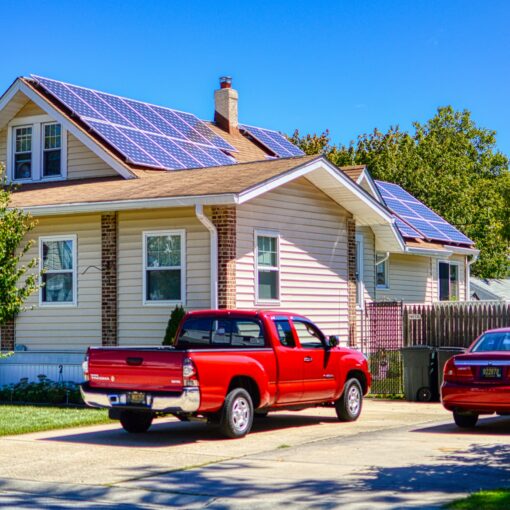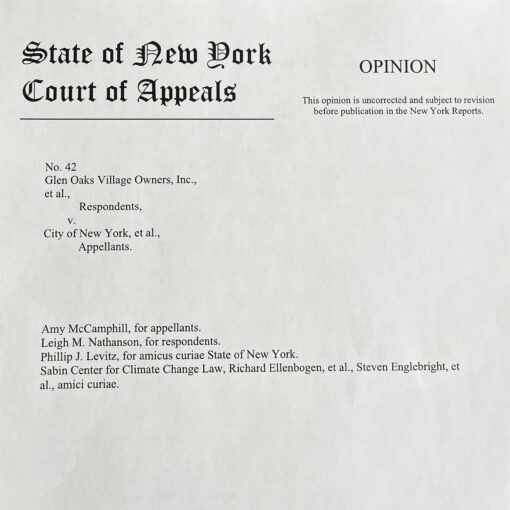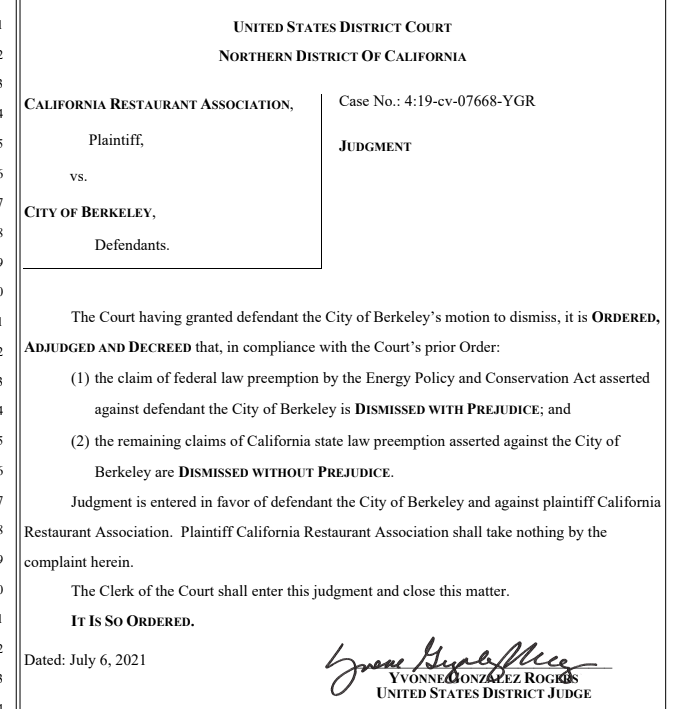 Last week, the New York State Supreme Court for New York County dismissed Glen Oaks Village Owners v. City of New York, a 2022 lawsuit brought by a group of cooperative apartment and other building owners seeking to invalidate Local Law 97 of 2019, New York City’s building performance standard to reduce greenhouse gas emissions from the City’s largest buildings. This is big news for New York City, which is relying on Local Law 97 to reduce 80% of emissions from the building sector, the largest contributor to the City’s total greenhouse gas emissions. As two leading Local Law 97 lawyers wrote, “[t]he decision provides clarity to the NYC real estate community that Local Law 97 is valid, enforceable, and constitutional.”
Last week, the New York State Supreme Court for New York County dismissed Glen Oaks Village Owners v. City of New York, a 2022 lawsuit brought by a group of cooperative apartment and other building owners seeking to invalidate Local Law 97 of 2019, New York City’s building performance standard to reduce greenhouse gas emissions from the City’s largest buildings. This is big news for New York City, which is relying on Local Law 97 to reduce 80% of emissions from the building sector, the largest contributor to the City’s total greenhouse gas emissions. As two leading Local Law 97 lawyers wrote, “[t]he decision provides clarity to the NYC real estate community that Local Law 97 is valid, enforceable, and constitutional.”
The decision is also big news for those of us who follow city climate law and policy around the country. Because the plaintiffs made so many of the claims typically brought by parties seeking to invalidate local laws, and because the court sets out its analysis in dismissing with each of them, the decision serves as somewhat of a master class in local authority to enact ambitious climate laws. The decision is most plainly relevant in New York State, where it offers a helpful guide through the many claims that are commonly used to challenge local laws in the state. But it also offers a broader primer to local governments elsewhere. The details of those states’ laws differ, but there are many commonalities in the kinds of claims that are often brought by opponents of local laws, and the decision can be used as a roadmap from which to assess the laws of other states. This post discusses the court’s holding with respect to each of the plaintiffs’ claims.
Local Law 97 is Not Preempted by New York State’s Climate Law
The plaintiffs’ broadest argument, and one that may be brought in other states, is that New York State’s 2019 marquee climate law, the Climate Leadership & Community Protection Act (CLCPA), preempts Local Law 97. While the preemption claim rang hollow to observers from the start, the idea that the ambitious climate laws passed in states like New York, Massachusetts, Minnesota, and California could limit local authority on climate was troublesome. In many parts of the country, state and local efforts on climate are pursued in parallel, and largely happily. Where states intend to preempt aspects of local climate policy, they can do so expressly – but the state laws at issue are generally not in conflict with local initiatives. (In many states, of course, local governments do not enjoy such productive relationships with their state governments.)
The court holds that the CLCPA does not preempt Local Law 97. First, the court establishes that New York State’s Constitution and Municipal Home Rule Law provide the City with “broad powers with respect to the protection of the health and safety of” residents, a source of authority referred to as the “police power.” The City relied on this police power in enacting Local Law 97.
It is not inconceivable that a state climate law could preempt a local one; the court writes that a local law “may be invalidated as inconsistent with State law not only where an express conflict exists between State and local laws, but also where the State has clearly evinced a desire to preempt an entire field thereby precluding any further regulation” [internal quotations and emphasis removed]. These two kinds of preemption are referred to as conflict preemption and field preemption, respectively. The court notes that field preemption “may be inferred from a declaration of State policy by the Legislature or from the legislative enactment of a comprehensive and detailed regulatory scheme in a particular area.” However, reaching such an inference requires “a particular showing that the local law is inconsistent with the Constitution or any” other State law [internal quotations omitted]. In other words, inferred field preemption is a two part-test: First, was there a declaration of State policy by the Legislature and/or a comprehensive and detailed regulatory scheme? And second, is the local law inconsistent with State law?
The Glen Oaks plaintiffs, according to the court, “failed to address” the second part of the two-part test. It seemed that the plaintiffs were impliedly arguing that, since the two laws both relate to emissions reductions, the local law must be preempted, but this is not the full legal test. Rather, the court noted that plaintiffs had “not identified an inconsistency [between Local Law 97 and the CLPCA] on which to base an inference of preemption.” The court further notes that the State’s CLCPA Scoping Plan harmonizes the CLCPA and Local Law 97 by noting that the Climate Action Council, which was tasked with developing the plan, noted that any State building compliance standards would “align with New York City’s Local Law 97 and across State and local governments where appropriate.” Not only were the two laws consistent, according to the court, but also were intended to be coordinated with one another.
Assuming the Glen Oaks ruling stands (plaintiffs appear primed to appeal), the decision settles the matter of whether local climate laws are preempted by the CLCPA merely because they both relate to emissions reductions. A local climate law may still conflict or be inconsistent with the CLCPA and any such claims will need to be considered on a case-by-case basis. But the ruling clearly establishes that a local law is not preempted by the CLCPA merely because it has to do with climate or emissions reductions, or even because it regulates emissions in a sector also addressed by the CLCPA.
As the Glen Oaks decision comes from a New York State court, it does not have any direct bearing on preemption claims in other states. Further, preemption law works differently in every state. But there is a broader takeaway from the court’s holding: it is possible to harmonize state and local climate laws, even where those state laws are broad and ambitious.
Local Law 97’s Penalties Do Not Constitute an Improper Tax
A second claim brought by the plaintiffs is an allegation that Local Law 97’s noncompliance penalties – which can run as high as $268 per ton of greenhouse gas emitted in excess of a building’s carbon cap – constitutes a tax on emissions that the City lacks authority to impose. The court quickly dispenses with the plaintiffs’ argument.
Three legal concepts are at play here.
- A fee, which local governments in New York State have authority to impose, so long as imposition of the fee is “reasonably necessary to the accomplishment of [a local law’s] regulatory purpose and… tethered to a benefit… received from the government.”
- A penalty, which is defined as “a sum of money for which the law exacts payment by way of punishment for doing some act which is prohibited, or omitting some act which is required to be done.” Local governments in New York State also have authority to impose penalties.
- A tax, which local governments do not have authority to assess without state legislative authorization, has as its “primary purpose… to raise money for support of the government generally” [internal quotations omitted throughout this paragraph].
The court writes that plaintiffs’ argument that Local Law 97’s fine structure constitutes an impermissible tax is inapposite in this case, where the fines are structured as penalties. For instance, plaintiffs argued that Local Law 97’s penalties “are not reasonably necessary to the accomplishment of Local Law 97’s purpose, as the government can plainly reduce emissions” other ways; this is the legal test for fees, not penalties. Local governments in New York have express authority under the Municipal Home Rule Law to impose penalties separate and apart from their authority to impose fees.
The court’s decision affirms that local governments may impose financial penalties for failure to comply with laws relating to air emissions, and that doing so does not constitute the assessment of an unauthorized tax. Again, the Glen Oaks decision has no legal bearing outside of New York State, but it does suggest that local governments should pay close attention to the distinctions between penalties, fees, and taxes, and that in many states a properly structured penalty will be distinguishable from an unlawful tax.
The Law’s Penalties Do Not Constitute Excessive Fines
The Glen Oaks plaintiffs brought three additional claims alleging that Local Law 97 deprives them of their due process rights. While the claims were each brought separately, and so are described separately in this post, the court sets out the basic two-part test that laws enacted pursuant to a local government’s police power must satisfy to survive due process review: “(1) it must have been enacted in furtherance of a legitimate governmental purpose, and (2) there must be a reasonable relation between the end sought to be achieved by the regulation and the means achieved to use that end” [internal quotations omitted]. Due process rights exist in both the U.S. and New York State Constitutions, and apply in all states.
The first of the due process claims is an allegation by plaintiffs that the Local Law 97 fines of $268 per ton of excess carbon released “are so excessive that they will deprive them of property without due process of law,” in violation of both the federal and state Constitutions. The court has, in essence, two responses to this argument. First is that the size of the penalty is “within the domain of legislative and discretion because [it] involve[s] choices among alternative reasonable courses of action.” In other words, the City was within its rights to address the “massive problem” of building greenhouse gas emissions in the way that it did, including by establishing the penalty. And second, the court broke down the penalty amounts the plaintiffs claimed they would incur, noting that, for example, a $1.1 million yearly penalty amount spread out over one of the plaintiff’s cooperative units would amount to $31.46 monthly per unit, which the court implies is reasonable given the value of the units.
What the Glen Oaks decision stands for, in this regard, is that local governments in New York may impose fines or monetary penalties for noncompliance with climate laws, and those fines need not be nominal. The decision does not get into what dollar level would constitute an excessive fine, so it’s not feasible to speculate on an upper limit, but a wide range of penalty amounts would be permissible as a matter of legislative discretion. The law on excessive penalties may be different in other states, and in some instances state law may limit local authority to impose fines or penalties in other ways, such as by statute. But in states where the amount of a permissible fine is a matter of due process, the Glen Oaks decision offers a framework for analyzing whether a penalty – even a large one – would be constitutional.
Local Law 97 Is Not Retroactive
Another of plaintiffs’ due process claims is that “their due process rights are being violated by [the] ‘retroactive’ application of Local 97.” The claim is somewhat tortuous because Local Law 97 applies only prospectively – the first compliance period has yet to begin – but plaintiffs argue that they constructed their buildings “based on environmental requirements that were in place at earlier points in time” and that they should not be “punish[ed]” for failing to predict future requirements. The court has little patience for this argument. Quoting an earlier case, Oriental Blvd. Co. v. Heller, 27 NY2d 212 (1970), the court writes: “The rule is that an owner of property who has constructed or maintained his property in compliance with laws then in existence acquires no vested right or immunity against… additional or new requirements.” One gets the sense that plaintiffs’ retroactivity claim was one of their more specious arguments; nonetheless, the decision rejects the notion that prospective requirements for buildings should be considered retroactive.
Local Law 97 Is Not Unconstitutionally Vague
The last of plaintiffs’ due process claims is an allegation that Local Law 97 is “unconstitutionally vague,” meaning, according to plaintiffs, that it “fails to provide people of ordinary intelligence a reasonable opportunity to understand what conduct it prohibits,” which could lead to inconsistent enforcement. Essentially, plaintiffs are arguing that because Local Law 97 is complex and allows for some flexibility, its requirements are vague. The court rejects this contention, quoting Foss v. City of Rochester, 65 NY2d 247 (1985), which states that “[d]ue process requires only a reasonable degree of certainty so that individuals of ordinary intelligence are not forced to guess at the meaning of statutory terms.” Plaintiffs also take issue with Local Law 97’s lack of specificity in defining “aggravating or mitigating factors” applied for purposes of determining a penalty, and with the inclusion of criteria such as “reasonable” and “good faith.” Quoting federal law cases in New York, the court observes that “a statue is not void for vagueness merely because it uses the word ‘reasonable’ or ‘unreasonable.’” (The court also notes that a facial vagueness challenge, as the Glen Oaks challenge is, faces a particularly high burden to be successful.)
Conclusion
The Glen Oaks decision is helpful one not only because it upholds Local Law 97 itself, but also because establishes that local governments in New York state have broad latitude to regulate greenhouse gas emissions pursuant to their police power. While the decision covers well-trod areas of the law, the questions it addresses are ones that have given local governments some pause – few local governments want to be sued, even if the law is ultimately on their side. As a case in state court, Glen Oaks is not directly applicable in states other than New York, but the legal claims that can arise in opposition to local decarbonization laws share similarities from place to place, and the decision is one of the first to outline the way that the local police power; due process rights; penalties, fees, and taxes; and state law preemption can work in local climate law context. It thus charts a course for defending local climate action across New York State and the country.
Amy Turner is the Director of the Cities Climate Law Initiative at the Sabin Center for Climate Change Law at Columbia Law School.





